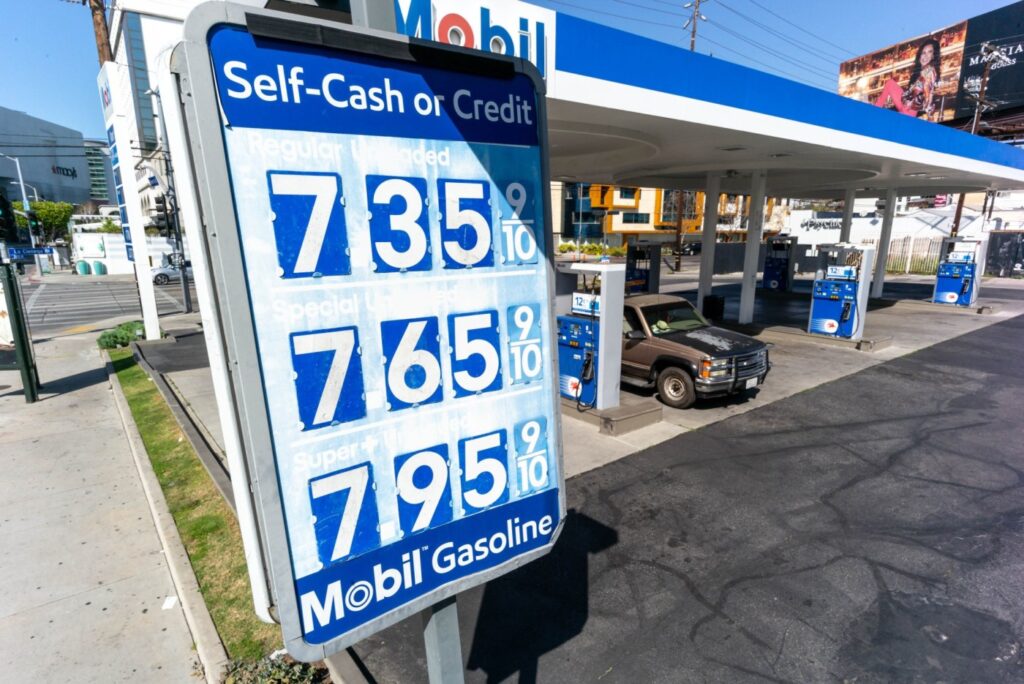
Lockdowns, masks, paycuts, layoffs … gas prices.
Southern California workers have faced myriad pandemic-related pivots over the past two years, forever altering their mindset and workflow.
Add rising gas prices to the list of challenges.
As average gas prices near $6 a gallon, companies are facing a new headache: Will the cost of the commute delay in a return to the office?
Record-high gas prices have added another reason to continue working from home. And when that remote-work option disappears, some employees are quitting and seeking new remote jobs, said Sarah Grimstead, a regional vice president with national human resources provider Insperity.
With Southern California prices surging — and in some cases topping $6 a gallon — most employees who have been working from home aren’t anxious to return to the daily grind of freeway gridlock. (File photo by Andrew Foulk, Contributing Photographer)
“When you look at the broad picture, the entire employment landscape has changed, and there has been record employee turnover,” Grimstead said. “Companies were already working to attract and retain talent with things like signing bonuses. Gas prices are just the next thing to pile on.”
At least 4.3 million Americans quit their job in January, according to recent data from the Bureau of Labor Statistics.
Ravin Jesuthasan, a workplace expert with consulting firm Mercer, said some of his corporate clients have pulled back on returning workers to the office — at least until the fuel surge subsides.
“We are seeing many organizations start to take a step back in light of a very dramatic and rampant spike in gas prices,” Jesuthasan told CBS MoneyWatch. “They’re saying, ‘Actually, let’s wait and see how this plays out. Let’s wait for gas prices to start to subside and let’s not rush back to the office at this point.’”
If current trends continue, fuel prices likely won’t be subsiding soon.
The average price for a gallon of regular gas hit records in four Southern California counties on Friday.
In Los Angeles County the price reached $5.91, up $1.12 in 24 consecutive days of increases. That’s $1.98 more than a year ago, the Automobile Club of Southern California reported. Dozens of local stations are selling regular-octane gasoline for $6.57 to $7.19 a gallon, with one station topping $7.50.
Orange County’s average price reached $5.87, Riverside County $5.79 and San Bernardino 5.81.
Laura Espitia was keenly aware of the price spike when she fills up her Honda Pilot, which she uses to run errands and shuttle her children to and from school.
“It used to cost me about $65,” the 36-year-old Canyon Country resident said. “But now, depending on where I go, it’s up to $85. I filled the car up four days ago and now I’ve got to fill up again. And it’s not just gas — prices are up on everything at the grocery store.”
Low-wage workers – the hardest hit
Rising fuel costs have been especially hard on low-wage workers in the restaurant and hospitality industries who never had the option of working from home.
Robert Rauch, a managing partner with RAR Hospitality is looking for ways to help his employees.
RAR employs more than 100 workers at three San Diego hotels — a Homewood Suites by Hilton, a Hilton Garden Inn and a Fairfild Inn & Suites by Marriott.
“We just had a discussion about giving our employees gas gift cards,” he said. “We haven’t come up with how much to give, but we’ll do something.”
Gov. Gavin Newsom has proposed postponing a California gas tax that’s scheduled for July, but several members of the state Assembly are pushing instead for a $400 gas rebate for every taxpayer in the state.
Rauch figures either scenario would help his employees.
“We’re already $1 a gallon above almost every other state,” he said. “I think a combination of action by the governor and temporary help from our management team is the way to go.”
Yaamava Resort & Casino in Highland doesn’t offer gas stipends or gift cards, but it does have a commuter program that allows employees to earn up to $2 a day for days they commute by walking, biking, carpooling or riding public transportation.
“We have dozens of employees who are part of the program, said Jasmine Takeshita, the casino’s talent acquisition director.
The casino also continues to offer sign-on bonuses for new employees, as well as thank-you bonuses for current workers and discretionary bonuses for employees, based on work performance and other metrics.
“It’s been a challenging hiring environment,” Takeshita said. “But we’re big on benefits and growth and development.”
Driver surcharges
App-based rideshare and delivery services are already offering relief to their drivers through per-mile gas surcharges and gas rewards.
Uber and Lyft introduced 55-cent-per-trip fuel surcharges this week that go directly to their drivers, and DoorDash is rolling out a gas “rewards program” giving U.S. delivery drivers a prepaid business Visa debit card, which offers 10% cashback on gas.
“Our weekly gas bonus … could lead to savings of anywhere between $1.65 and $2 per gallon,” DoorDash spokeswoman Briana Megid said.
A word of caution
Grimstead said employers who wish to help their workers offset high gas prices should proceed carefully.
“We would caution them to remember that anything they provide to employees will be perceived as a negative when it’s taken away,” she said. “If you add it to their payroll make sure it’s a separate line item because people get very used to a higher check, and it hurts when that’s not there anymore.”
Grimstead likened it to the hero bonuses grocery chain offered their workers at the height the COVID-19 pandemic. They were warmly received when they kicked in, but deeply resented when they were taken away.
Beyond all that, there is the fear factor.
“We just don’t know when things will get back to normal,” Grimstead said. “That fear of the unknown is very real for employees.”
